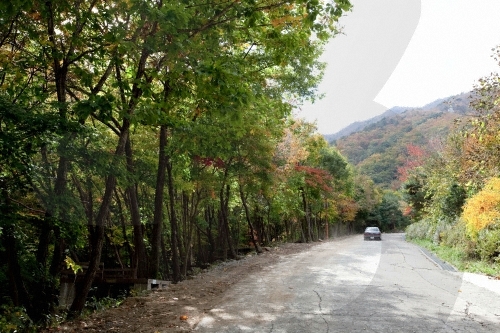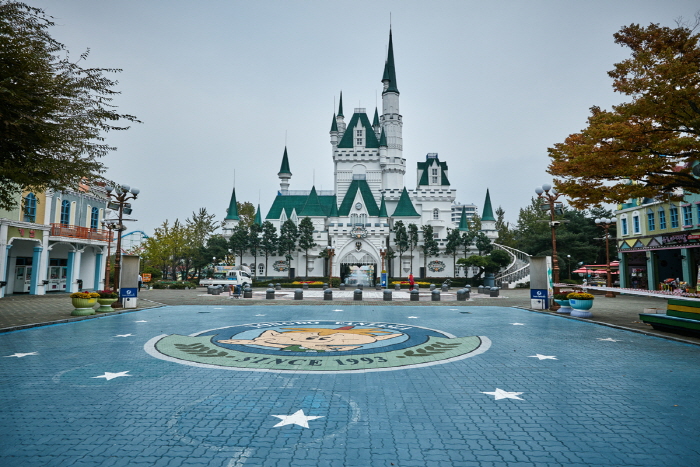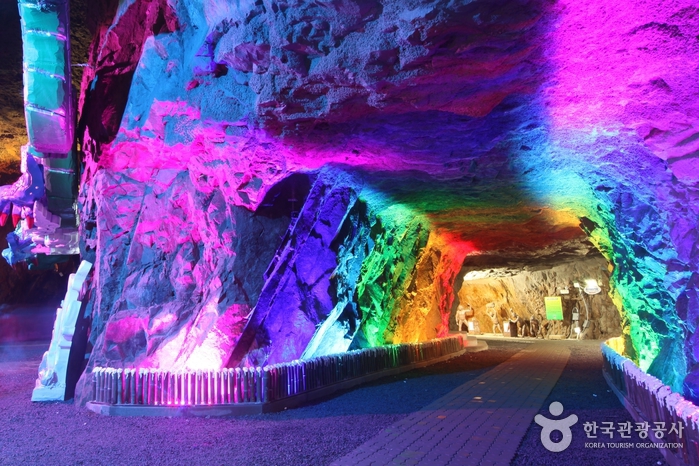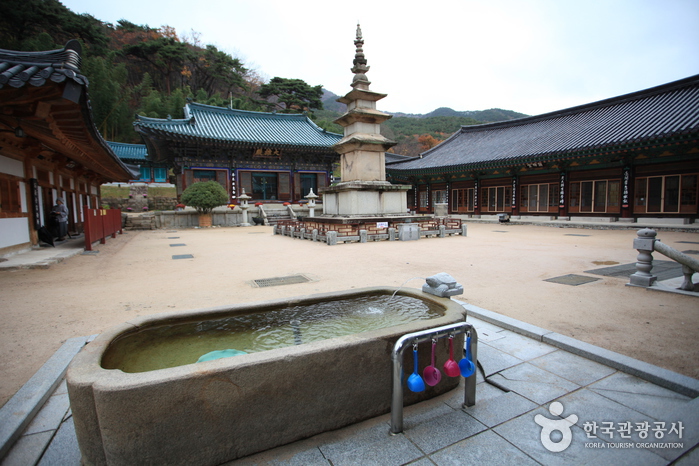Deungeok Hot Springs (등억온천단지)
10.5 Km 15062 2020-03-19
197, Alpeuseuoncheon-ro, Ulju-gun, Ulsan
+82-52-277-0101
Situated on the outskirts of Sinbulsan Mountain (part of the Yeongnam mountain range, in southeastern Korea), Deungeok Hot Springs (72,727m²) is a sprawling geothermal site which includes the Sinbulsan, Eonyang, and Gajisan Hot Springs. Nearby to the Sinbulsan, Gajisan, and Ganwolsan Mountains of the Yeongnam mountain range, the complex is ideal for visitors seeking rest and relaxation after their hiking adventures.
The water found in the area contains high concentrations of sodium bicarbonate (substance similar to baking soda), which is believed to be a remedy for dermatitis, indigestion, bronchitis, high blood pressure, and many other ailments. Nearby attractions include Amethyst Cavern Park, Dokkaebi Road, Jakcheonjeong, Ganwol Natural Recreation Forest, and Seongnamsa Temple.
Unmunsan County Park (운문산군립공원)
10.7 Km 22506 2022-09-06
Unmun-myeon, Cheongdo-gun, Gyeongsangbuk-do
+82-54-370-6114
Unmunsan Mountain (1,118 meters) is one of the seven mountains rising over 1,000 meters above sea level in the Yeongnam Alps in the Taebaeksanmaek Mountain Range. Unmunsan Mountain features dense groves, attracting a large number of hikers. From the summit, one can get a great view of the golden reeds on Cheonhwangsan Mountain to the south, and the ridges of Gajisan Mountain to the east.
There are various sized temples and hermitages on the mountain, nestled among a splendid landscape. Unmunsa Temple is situated at the foot of the mountain on the northern side. It was built by Sinseung in the 18th year of the reign of King Jinheung (557) of the Silla Kingdom. Though some buildings burned down during the Imjin War, the Obaengnahanjeon Hall and Gwaneumjeon Hall have been preserved in their original state. The dense groves of pine trees and fir trees add to the tranquility of the beautiful scenery. In the temple, seven treasures are kept, including the Stone Lantern at Geumdang Hall (Treasure). The historic relics date back to the Silla kingdom and Goryeo dynasty.
Eden Valley Ski Resort (에덴밸리스키장 (에덴밸리리조트))
10.9 Km 63206 2021-12-21
1206, Eosil-ro, Yangsan-si, Gyeongsangnam-do
+82-55-379-8000
Located in Yangsan, Gyeongsangnam-do, Eden Valley Resort ski slopes have been scientifically designed to disperse skiers and prevent overcrowding. Various slope types are available for skiers and snowboarders of diverse skill levels. Visitors can enjoy winter leisure sports in this international-standard ski resort.
Seokgolsa Temple (석골사)
11.0 Km 20567 2024-02-23
167 Wonseo 3-gil, Sannae-myeon, Miryang-si, Gyeongsangnam-do
Seokgolsa Temple, located on Unmunsan Mountain in Miryang, is surrounded by a series of peaks including Unmunsan Mountain to the north, Gajisan Mountain to the east, and Eoksan Mountain to the west. The temple is set in a picturesque landscape, adorned with unique rock cliffs and deep valleys. Below Seokgolsa Temple, the perennial Seokgolsapokpo Falls and valley captivate visitors with their continuous flow of water, attracting a steady stream of tourists and hikers throughout the year.
Tongdo Fantasia (통도환타지아)
11.0 Km 28424 2022-09-26
68, Tongdo 7-gil, Yangsan-si, Gyeongsangnam-do
+82-55-379-7000
Tongdo Fantasia is located in Yangsan, Gyeongsangnam-do, which shares borders with Milyang, Ulsan and Busan. This makes the amusement park very accessible by any means of transportation. Tongdo Fantasia operates Tongdo Country Club as well, and nearby Tongdosa Temple is also available for visitors who want to look around the local historic sites. The amusement park, the biggest theme park in Gyeongsangnam-do sits at the foot of Yeongchwisan Mountain, has over 30 amusement facilities, a large-scale swimming pool, a natural lake, a plaza for various events and a large-scale outdoor theatre, all offering various activities and events.
Gyeonggi Sikdang (경기식당)
11.1 Km 23502 2024-02-23
86 Sinpyeonggangbyeon-ro, Habuk-myeon, Yangsan-si, Gyeongsangnam-do
Gyeonggi Sikdang is nestled near the Tongdosa Temple, one of Korea's three major temples. It is celebrated for its expertise in Korean cuisine. The restaurant's signature dish is sanchae bibimbap (wild vegetable bibimbap), a vibrant mix of at least five types of namul (salad) harmoniously blended with their homemade gochujang (red chili paste). Each order is thoughtfully paired with an array of side dishes and a complementary soup. In addition to this signature dish, Gyeonggi Sikdang's menu boasts a diverse selection of Korean specialties, such as deodeok gui (grilled deodeok), dotorimuk (acorn jelly salad), pajeon (green onion pancake), and baeksuk (whole chicken soup).
Amethyst Cavern Park (자수정동굴나라)
12.0 Km 105568 2022-09-06
212, Jasujeong-ro, Ulju-gun, Ulsan
+82-52-254-1515
Amethyst Cavern Park is the largest man-made cave tourist attraction in Korea, where one of the five jewels of the World, amethyst, was mined. Connected like a labyrinth, the cave is 2.5 kilometers long and fills an area of approximately 15,000 square meters. The average temperature is between 12 and 16 degrees Celsius year round. Visitors can take either the walking tour that goes through a different themed halls or take a boat ride through the cave river. On the second floor of the cave, visitors can see Jurassic World filled with different dinosaurs and character lamps.
Maneosa Temple (만어사)
12.6 Km 30318 2024-02-23
776 Maneo-ro, Samnangjin-eup, Miryang-si, Gyeongsangnam-do
Maneosa Temple, perched on Maneosan Mountain in Miryang, dates back to 46 A.D. and is steeped in tradition and numerous legends. During the Silla dynasty, it served as a ceremonial site for the king to conduct Buddhist rites. Notably, beneath the Mireukjeon Hall lies the Maneoseok Rocks, reputed to be fish that transformed into stones. Remarkably, these stones emit a clear, bell-like sound when struck, earning them the nickname Jongseok (Bell stone). The temple also features a three-story stone pagoda, standing 3.7 meters tall, which has been designated as a Treasure.
Seongnamsa Temple (석남사 울산)
12.8 Km 19404 2020-03-17
557, Seongnam-ro, Ulju-gun, Ulsan
+82-52-264-8900
The name of the temple is believed to have originated from the fact that it is located south of Gajisan Mountain or Seokansan Mountain. Built in 824 A.D. (during the 16th year of King Heondeok’s reign), the temple was destroyed during the Japanese Invasions of Korea (1592-1598) and rebuilt in 1674 (during the 15th year of King Hyeongjong’s reign). Since then, it has gone through rebuilding several times. Consisting of 30 buildings, the temple is home to many Buddhist nuns.
Seongnamsa Three Story Pagoda (Local Tangible Cultural Property No. 5) was built in 824 A.D. by Monk Doui, reflecting his wish of protecting the country from foreign invasions. The pagoda was initially placed in front of Daeungjeon, but moved to the current location in 1973. Other notable relics in the temple include the Statue of Monk Doui (National Treasure No. 369), Three Story Sarira Pagoda, and Stone Water Tank (Cultural Property Material No. 4).
Wondong Recreational Forest (원동자연휴양림)
13.8 Km 174466 2024-02-23
69 Neulbat-ro, Wondong-myeon, Yangsan-si, Gyeongsangnam-do
Wondong Recreational Forest is situated where Gajisan Mountain – often referred to as the Alps of Korea – meets Yeongchuksan Mountain. It is celebrated for its breathtaking landscape, which includes valleys, dense forests, and waterfalls. This forest provides an ideal setting for forest bathing, allowing visitors to immerse themselves in nature along the crystal-clear waters of the valley, surrounded by unique rock formations. Additionally, with the largest campground in Wondong, the Wondong Recreational Forest attracts numerous tourists seeking a serene camping experience amidst natural beauty.





 English
English
 한국어
한국어 日本語
日本語 中文(简体)
中文(简体) Deutsch
Deutsch Français
Français Español
Español Русский
Русский